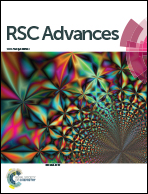From wheat bran derived carbonaceous materials to a highly stretchable and durable strain sensor†
Abstract
Highly stretchable strain sensors with exceptional sensitivity and durability are essential for applications in human health monitoring, soft robotics, etc. The majority of stretchable strain sensors are composite materials using conductive fillers to produce sensitivity and an elastic polymer to acquire stretchability. However, it is difficult to develop highly sensing strain sensors meanwhile possessing stretchability, durability and frequency stability, all of which are particularly important for real use. The high strains applied always cause stress concentration around the conductive network, leading to unrepaired cracks during cyclic operations. It is challenging to design an appropriate composite structure where the interaction between fillers and polymers remains stable upon large deformations with minimal stress concentration. In this work, we created a strain sensor with a conductive network stacked with highly homogeneous carbon fragments from wheat bran derived carbonaceous materials, each of which apportioned the strain as equally as possible to minimize the local deformation and stress concentration. The sensor showed excellent durability over 10 000 stretching cycles at 80% strain with high sensitivity (gauge factor of 62.8) and frequency stability (0.01–1 Hz), among the highest recorded for stretchable strain sensors based on nanocarbon materials and biomass materials.



 Please wait while we load your content...
Please wait while we load your content...